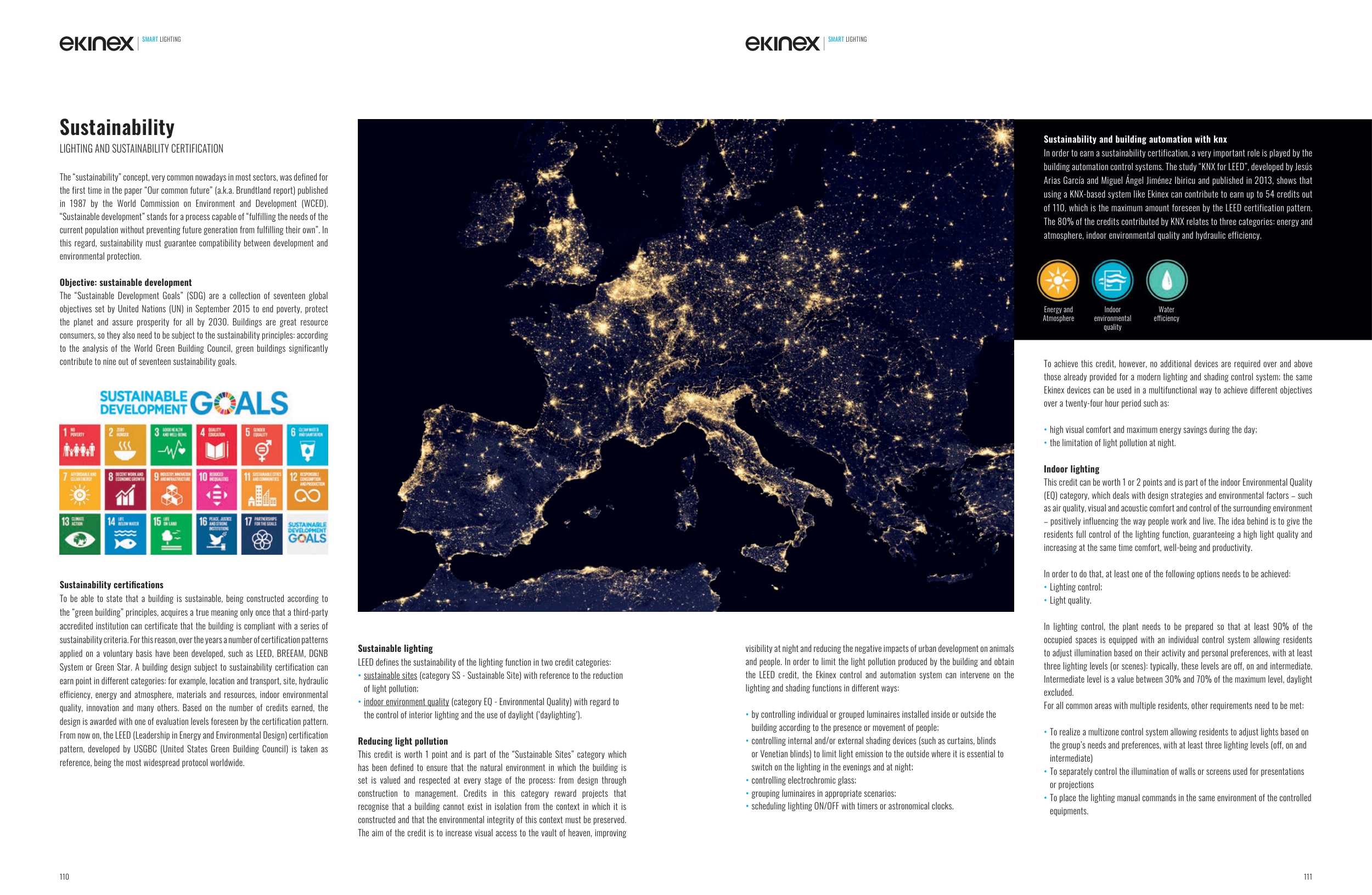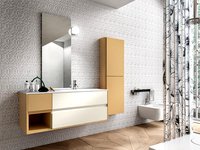Sustainable lighting
LEED defines the sustainability of the lighting function in two credit categories:
• sustainable sites (category SS - Sustainable Site) with reference to the reduction
of light pollution;
• indoor environment quality (category EQ - Environmental Quality) with regard to
the control of interior lighting and the use of daylight (‘daylighting’).
Reducing light pollution
This credit is worth 1 point and is part of the “Sustainable Sites” category which
has been defined to ensure that the natural environment in which the building is
set is valued and respected at every stage of the process: from design through
construction to management. Credits in this category reward projects that
recognise that a building cannot exist in isolation from the context in which it is
constructed and that the environmental integrity of this context must be preserved.
The aim of the credit is to increase visual access to the vault of heaven, improving
visibility at night and reducing the negative impacts of urban development on animals
and people. In order to limit the light pollution produced by the building and obtain
the LEED credit, the Ekinex control and automation system can intervene on the
lighting and shading functions in different ways:
• by controlling individual or grouped luminaires installed inside or outside the
building according to the presence or movement of people;
• controlling internal and/or external shading devices (such as curtains, blinds
or Venetian blinds) to limit light emission to the outside where it is essential to
switch on the lighting in the evenings and at night;
• controlling electrochromic glass;
• grouping luminaires in appropriate scenarios;
• scheduling lighting ON/OFF with timers or astronomical clocks.
Sustainability and building automation with knx
In order to earn a sustainability certification, a very important role is played by the
building automation control systems. The study “KNX for LEED”, developed by Jesús
Arias García and Miguel Ángel Jiménez Ibiricu and published in 2013, shows that
using a KNX-based system like Ekinex can contribute to earn up to 54 credits out
of 110, which is the maximum amount foreseen by the LEED certification pattern.
The 80% of the credits contributed by KNX relates to three categories: energy and
atmosphere, indoor environmental quality and hydraulic efficiency.
The “sustainability” concept, very common nowadays in most sectors, was defined for
the first time in the paper “Our common future” (a.k.a. Brundtland report) published
in 1987 by the World Commission on Environment and Development (WCED).
“Sustainable development” stands for a process capable of “fulfilling the needs of the
current population without preventing future generation from fulfilling their own”. In
this regard, sustainability must guarantee compatibility between development and
environmental protection.
Objective: sustainable development
The “Sustainable Development Goals” (SDG) are a collection of seventeen global
objectives set by United Nations (UN) in September 2015 to end poverty, protect
the planet and assure prosperity for all by 2030. Buildings are great resource
consumers, so they also need to be subject to the sustainability principles: according
to the analysis of the World Green Building Council, green buildings significantly
contribute to nine out of seventeen sustainability goals.
Sustainability certifi cations
To be able to state that a building is sustainable, being constructed according to
the “green building” principles, acquires a true meaning only once that a third-party
accredited institution can certificate that the building is compliant with a series of
sustainability criteria. For this reason, over the years a number of certification patterns
applied on a voluntary basis have been developed, such as LEED, BREEAM, DGNB
System or Green Star. A building design subject to sustainability certification can
earn point in different categories: for example, location and transport, site, hydraulic
efficiency, energy and atmosphere, materials and resources, indoor environmental
quality, innovation and many others. Based on the number of credits earned, the
design is awarded with one of evaluation levels foreseen by the certification pattern.
From now on, the LEED (Leadership in Energy and Environmental Design) certification
pattern, developed by USGBC (United States Green Building Council) is taken as
reference, being the most widespread protocol worldwide.
Sustainability
LIGHTING AND SUSTAINABILITY CERTIFICATION
To achieve this credit, however, no additional devices are required over and above
those already provided for a modern lighting and shading control system; the same
Ekinex devices can be used in a multifunctional way to achieve different objectives
over a twenty-four hour period such as:
• high visual comfort and maximum energy savings during the day;
• the limitation of light pollution at night.
Indoor lighting
This credit can be worth 1 or 2 points and is part of the indoor Environmental Quality
(EQ) category, which deals with design strategies and environmental factors – such
as air quality, visual and acoustic comfort and control of the surrounding environment
– positively influencing the way people work and live. The idea behind is to give the
residents full control of the lighting function, guaranteeing a high light quality and
increasing at the same time comfort, well-being and productivity.
In order to do that, at least one of the following options needs to be achieved:
• Lighting control;
• Light quality.
In lighting control, the plant needs to be prepared so that at least 90% of the
occupied spaces is equipped with an individual control system allowing residents
to adjust illumination based on their activity and personal preferences, with at least
three lighting levels (or scenes): typically, these levels are off, on and intermediate.
Intermediate level is a value between 30% and 70% of the maximum level, daylight
excluded.
For all common areas with multiple residents, other requirements need to be met:
• To realize a multizone control system allowing residents to adjust lights based on
the group’s needs and preferences, with at least three lighting levels (off, on and
intermediate)
• To separately control the illumination of walls or screens used for presentations
or projections
• To place the lighting manual commands in the same environment of the controlled
equipments.
Water
efficiency
Indoor
environmental
quality
Energy and
Atmosphere
SMART LIGHTING
SMART LIGHTING
110
111







